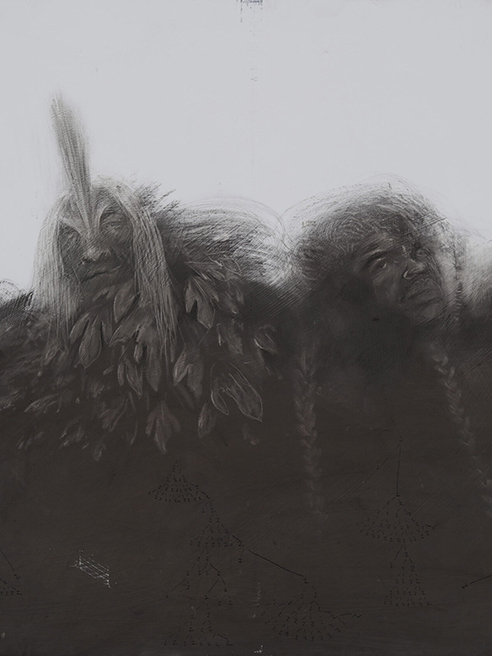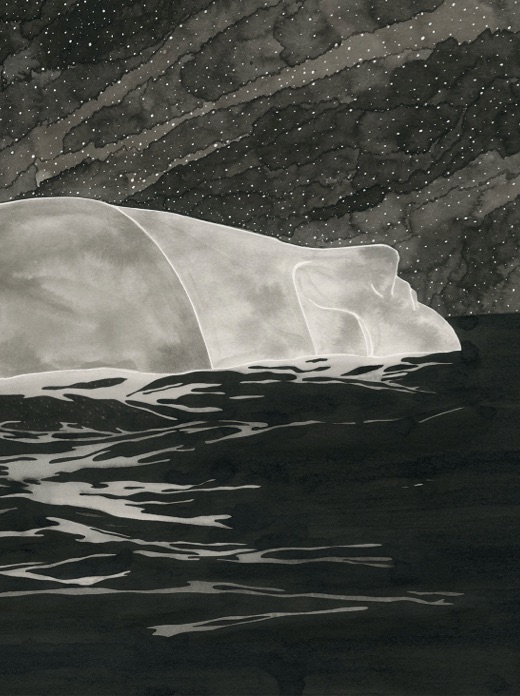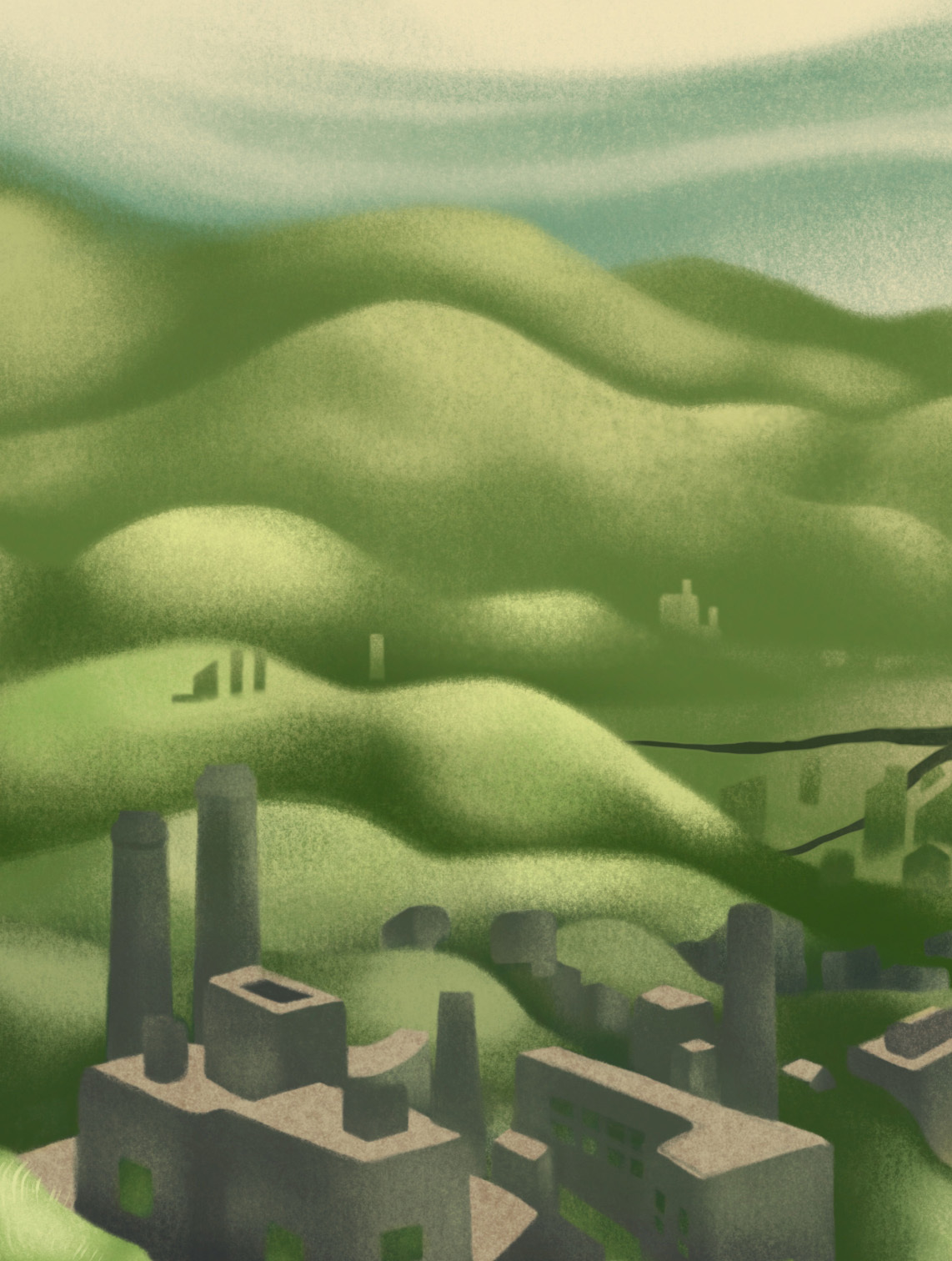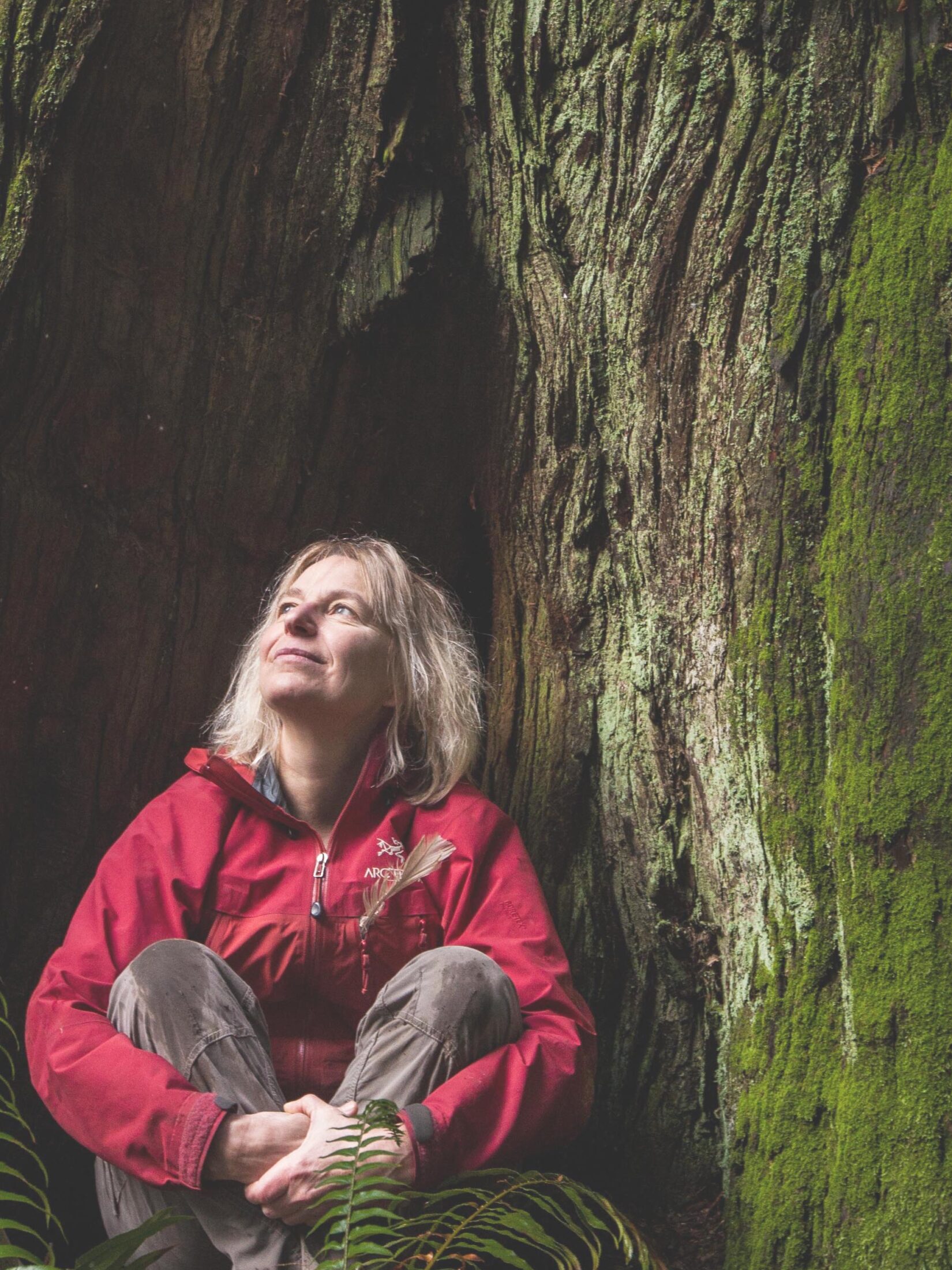


Artwork by Studio Airport
The Serviceberry
An Economy of Abundance
by Robin Wall Kimmerer
Robin Wall Kimmerer is a mother, scientist, professor, and enrolled member of the Citizen Potawatomi Nation. She is the author of Braiding Sweetgrass: Indigenous Wisdom, Scientific Knowledge and the Teachings of Plants. Kimmerer lives in Syracuse, New York, where she is a SUNY Distinguished Teaching Professor of Environmental Biology and the founder and director of the Center for Native Peoples and the Environment.
Studio Airport is Bram Broerse and Maurits Wouters. Together with a small team of creatives, they run a design practice based in Utrecht, the Netherlands. The studio has been recognized with international awards for projects such as Hart Island Project (New York), Amsterdam Art Council, and Greenpeace International.
As Robin Wall Kimmerer harvests serviceberries alongside the birds, she considers the ethic of reciprocity that lies at the heart of the gift economy. How, she asks, can we learn from Indigenous wisdom and ecological systems to reimagine currencies of exchange?
The cool breath of evening slips off the wooded hills, displacing the heat of the day, and with it come the birds, as eager for the cool as I am. They arrive in a flock of calls that sound like laughter, and I have to laugh back with the same delight. They are all around me, Cedar Waxwings and Catbirds and a flash of Bluebird iridescence. I have never felt such a kinship to my namesake, Robin, as in this moment when we are both stuffing our mouths with berries and chortling with happiness. The bushes are laden with fat clusters of red, blue, and wine purple in every stage of ripeness—so many, you can pick them by the handful. I’m glad I have a pail and wonder if the birds will be able to fly with their bellies as full as mine.
This abundance of berries feels like a pure gift from the land. I have not earned, paid for, nor labored for them. There is no mathematics of worthiness that reckons I deserve them in any way. And yet here they are—along with the sun and the air and the birds and the rain, gathering in the towers of cumulonimbi. You could call them natural resources or ecosystem services, but the Robins and I know them as gifts. We both sing gratitude with our mouths full.
Part of my delight comes from their unexpected presence. The local native Serviceberries, Amelanchier arborea, have small, hard fruits, which tend toward dryness, and only once in a while is there a tree with sweet offerings. The bounty in my bucket is a western species—A. alnifolium, known as Saskatoons—planted by my farmer neighbor, and this is their first bearing year, which they do with an enthusiasm that matches my own.
Saskatoon, Juneberry, Shadbush, Shadblow, Sugarplum, Sarvis, Serviceberry—these are among the many names for Amelanchier. Ethnobotanists know that the more names a plant has, the greater its cultural importance. The tree is beloved for its fruits, for medicinal use, and for the early froth of flowers that whiten woodland edges at the first hint of spring. Serviceberry is known as a calendar plant, so faithful is it to seasonal weather patterns. Its bloom is a sign that the ground has thawed and that the shad are running upstream—or at least it was back in the day when rivers were clear and free enough to support their spawning. The derivation of the name “Service” from its relative Sorbus (also in the Rose Family) notwithstanding, the plant does provide myriad goods and services. Not only to humans but to many other citizens. It is a preferred browse of Deer and Moose, a vital source of early pollen for newly emerging insects, and host to a suite of butterfly larvae—like Tiger Swallowtails, Viceroys, Admirals, and Hairstreaks—and berry-feasting birds who rely on those calories in breeding season.
In Potawatomi, it is called Bozakmin, which is a superlative: the best of the berries. I agree with my ancestors on the rightness of that name. Imagine a fruit that tastes like a Blueberry crossed with the satisfying heft of an Apple, a touch of rosewater and a minuscule crunch of almond-flavored seeds. They taste like nothing a grocery store has to offer: wild, complex with a chemistry that your body recognizes as the real food it’s been waiting for.
For me, the most important part of the word Bozakmin is “min,” the root for “berry.” It appears in our Potawatomi words for Blueberry, Strawberry, Raspberry, even Apple, Maize, and Wild Rice. The revelation in that word is a treasure for me, because it is also the root word for “gift.” In naming the plants who shower us with goodness, we recognize that these are gifts from our plant relatives, manifestations of their generosity, care, and creativity. When we speak of these not as things or products or commodities, but as gifts, the whole relationship changes. I can’t help but gaze at them, cupped like jewels in my hand, and breathe out my gratitude.
In the presence of such gifts, gratitude is the intuitive first response. The gratitude flows toward our plant elders and radiates to the rain, to the sunshine, to the improbability of bushes spangled with morsels of sweetness in a world that can be bitter.
Gratitude is so much more than a polite “thank you.” It is the thread that connects us in a deep relationship, simultaneously physical and spiritual, as our bodies are fed and spirits nourished by the sense of belonging, which is the most vital of foods. Gratitude creates a sense of abundance, the knowing that you have what you need. In that climate of sufficiency, our hunger for more abates and we take only what we need, in respect for the generosity of the giver.
If our first response is gratitude, then our second is reciprocity: to give a gift in return. What could I give these plants in return for their generosity? It could be a direct response, like weeding or water or a song of thanks that sends appreciation out on the wind. Or indirect, like donating to my local land trust so that more habitat for the gift givers will be saved, or making art that invites others into the web of reciprocity.
Gratitude and reciprocity are the currency of a gift economy, and they have the remarkable property of multiplying with every exchange, their energy concentrating as they pass from hand to hand, a truly renewable resource. I accept the gift from the bush and then spread that gift with a dish of berries to my neighbor, who makes a pie to share with his friend, who feels so wealthy in food and friendship that he volunteers at the food pantry. You know how it goes.
To name the world as gift is to feel one’s membership in the web of reciprocity. It makes you happy—and it makes you accountable. Conceiving of something as a gift changes your relationship to it in a profound way, even though the physical makeup of the “thing” has not changed. A woolly knit hat that you purchase at the store will keep you warm regardless of its origin, but if it was hand knit by your favorite auntie, then you are in relationship to that “thing” in a very different way: you are responsible for it, and your gratitude has motive force in the world. You’re likely to take much better care of the gift hat than the commodity hat, because it is knit of relationships. This is the power of gift thinking. I imagine if we acknowledged that everything we consume is the gift of Mother Earth, we would take better care of what we are given. Mistreating a gift has emotional and ethical gravity as well as ecological resonance.
How we think ripples out to how we behave. If we view these berries, or that coal or forest, as an object, as property, it can be exploited as a commodity in a market economy. We know the consequences of that.
Why then have we permitted the dominance of economic systems that commoditize everything? That create scarcity instead of abundance, that promote accumulation rather than sharing? We’ve surrendered our values to an economic system that actively harms what we love. I’m wondering how we fix that. And I’m not alone.
Because I’m a botanist, my fluency in the lexicon of berries may not easily extend to economics, so I wanted to revisit the conventional meaning of economics to compare it with my understanding of the gift economy of nature. What is economics for anyway? It turns out that answer depends a lot on who you ask. On their website, the American Economic Association says, “It’s the study of scarcity, the study of how people use resources and respond to incentives.” My son-in-law teaches high school economics, and the first principle his students learn is that economics is about decision-making in the face of scarcity. Anything and everything in a market is implicitly defined as scarce. With scarcity as the main principle, the mindset that follows is based on commodification of goods and services.
I’m way past high school, but I’m not sure I grasp that thinking, so I fill a bowl with fresh Serviceberries for my friend and colleague, Dr. Valerie Luzadis. She is an appreciator of earthly gifts and a professor and past president of the US Society for Ecological Economics. Ecological economics is a growing economic theory that expands the conventional definition by working to integrate Earth’s natural systems and human values. But it has not been standard practice to include these foundational elements—they are usually left out of the equation. Valerie prefers the definition that “economics is how we organize ourselves to sustain life and enhance its quality. It’s a way of considering how we provide for ourselves.”
The words “ecology” and “economy” come from the same root, the Greek oikos, meaning “home” or “household”: i.e., the systems of relationship, the goods and services that keep us alive. The system of market economies that we’re given as a default is hardly the only model out there. Anthropologists have observed and shared multiple cultural frameworks colored by very different worldviews on “how we provide for ourselves,” including gift economies.
As the berries plunk into my bucket, I’m thinking about what I’ll do with them all. I’ll drop some off for friends and neighbors, and I’ll certainly fill the freezer for Juneberry muffins in February. This “problem” of managing decisions about abundance reminds me of a report that linguist Daniel Everett wrote as he was learning from a hunter-gatherer community in the Brazilian rainforest. A hunter had brought home a sizable kill, far too much to be eaten by his family. The researcher asked how he would store the excess. Smoking and drying technologies were well known; storing was possible. The hunter was puzzled by the question—store the meat? Why would he do that? Instead, he sent out an invitation to a feast, and soon the neighboring families were gathered around his fire, until every last morsel was consumed. This seemed like maladaptive behavior to the anthropologist, who asked again: given the uncertainty of meat in the forest, why didn’t he store the meat for himself, which is what the economic system of his home culture would predict.
“Store my meat? I store my meat in the belly of my brother,” replied the hunter.
I feel a great debt to this unnamed teacher for these words. There beats the heart of gift economies, an antecedent alternative to market economies, another way of “organizing ourselves to sustain life.” In a gift economy, wealth is understood as having enough to share, and the practice for dealing with abundance is to give it away. In fact, status is determined not by how much one accumulates, but by how much one gives away. The currency in a gift economy is relationship, which is expressed as gratitude, as interdependence and the ongoing cycles of reciprocity. A gift economy nurtures the community bonds that enhance mutual well-being; the economic unit is “we” rather than “I,” as all flourishing is mutual.
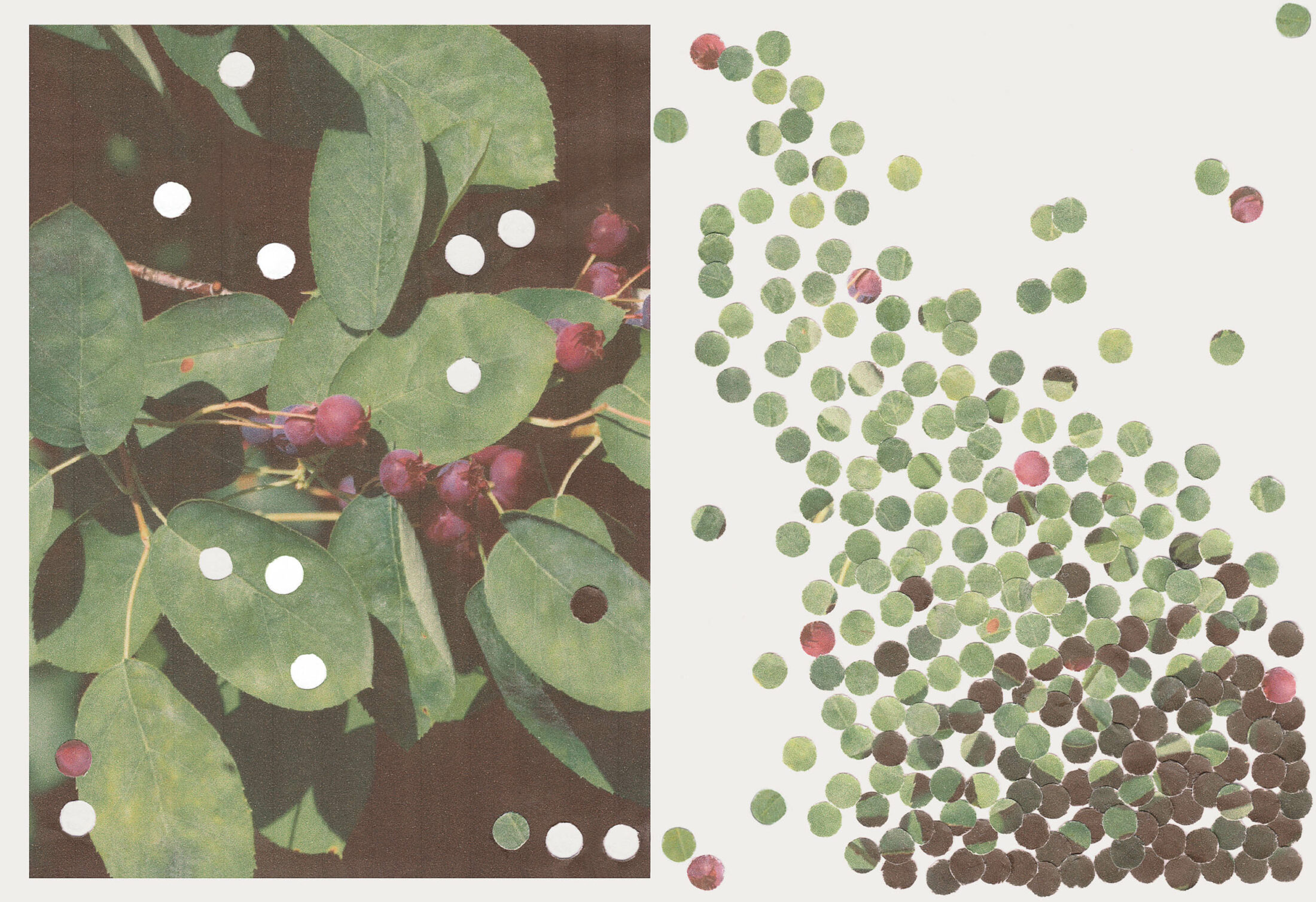
Anthropologists characterize gift economies as systems of exchange in which goods and services circulate without explicit expectations of direct compensation. Those who have give to those who don’t so that everyone in the system has what they need. It is not regulated from above but derives from a collective sense of equity and accountability in response to the gifts of the Earth.
In his book Sacred Economics, Charles Eisenstein states: “Gifts cement the mystical realization of participation in something greater than oneself which, yet, is not separate from oneself. The axioms of rational self-interest change because the self has expanded to include something of the other.” If the community is flourishing, then all within it will partake of the same abundance—or shortage—that nature provides.
The currency of exchange is gratitude and relationship rather than money. It includes a system of social and moral agreements for indirect reciprocity. So, the hunter who shared the feast with you could well anticipate that you would share from a full fishnet or offer your labor in repairing a boat.
The natural world itself is understood as a gift and not as private property; as such, there are ethical constraints on the accumulation of abundance that is not yours. Well-known examples of gift economies include potlatches or the Kula ring cycle, in which gifts circulate in the group, solidifying bonds of relationship and redistributing wealth.
The question of abundance highlights the striking difference between the market economies which have come to dominate the globe and the ancient gift economies which preceded them. There are many examples of functioning gift economies—most in small societies of close relations, where community well-being is recognized as the “unit” of success—where the interest of “we” exceeds that of “I.” In this time when the economies have grown so large and impersonal that they extinguish rather than nurture community well-being, perhaps we should consider other ways to organize the exchange of goods and services which constitute an economy.
In a market economy, where the underlying principles are scarcity and maximizing return on investment, the meat is private property, accumulated for the well-being of the hunter or exchanged for currency. The greatest status and success comes from possession. Food security is assured by private accumulation.
In contrast, gift economies arise from the abundance of gifts from the Earth, which are owned by no one and therefore shared. Sharing engenders relationships of goodwill and bonds that ensure you will be invited to the feast when your neighbor is fortunate. Security is ensured by nurturing the bonds of reciprocity. You can store meat in your own pantry or in the belly of your brother. Both have the result of keeping hunger at bay but with very different consequences for the people and for the land which provided that sustenance.
I haven’t studied economics in decades, but as a plant ecologist, I’ve spent a lifetime asking the plants for their guidance on any number of issues; so I wondered what the Serviceberries had to say about the systems which create and distribute goods and services. What is their economic system? How do they respond to the issues of abundance and scarcity? Has their evolutionary process shaped them to be hoarders or sharers?
Let’s ask the Saskatoons. These ten-foot-tall trees are the producers in this economy. Using the free raw materials of light, water, and air, they transmute these gifts into leaves and flowers and fruits. They store some energy as sugars in the making of their own bodies, but much of it is shared. Some of the abundance of spring rain and sun manifests in the form of flowers, which offer a feast for insects when it’s cold and rainy. The insects return the favor by carrying pollen. Food is rarely in short supply for Saskatoons, but mobility is rare. Movement is a gift of the pollinators, but the energy needed to support buzzing around is scarce. So they create a relationship of exchange that benefits both.
We’ve surrendered our values to an economic system that actively harms what we love.
In summer, when the boughs are laden, Serviceberry produces an abundance of sugar. Does it hoard that energy for itself? No, it invites the birds to a feast. Come, my relatives, fill your bellies, say the Serviceberries. Are they not storing their meat in the bellies of their brothers and sisters—the Jays, the Thrashers, and the Robins?
Isn’t this an economy? A system of distribution of goods and services that meets the needs of the community? The currency of this economic system is energy, which flows through it, and materials, which cycle among the producers and the consumers. It is a system for redistribution of wealth, an exchange of goods and services. Each member has an abundance of something, which they offer to others. The abundance of berries goes to the birds—for, what use are berries to the tree other than a way to make relationships with birds?
Eating too many berries has the same effect on birds as it does on people. Fuchsia splats decorate the fence posts. This of course is the whole point of berries—to make themselves so irresistible and plentiful that birds will come and feast, as we are doing this evening, and then distribute the seeds far and wide. Feasting has another benefit. Passage through a bird gut scarifies the seeds to stimulate germination. The birds provide services to the Serviceberries, who provide for them in return. The relationships created by the gift weave myriad relations between insects and microbes and root systems. The gift is multiplied with every giving, until it returns so rich and sweet that it burbles forth as the birdsong that wakes me in the morning. If the abundance had been hoarded, if Juneberries acted solely for their own benefit, the forest would be diminished.
Charles Eisenstein expresses that we have created a grotesque economy that grinds what is beautiful and unique into money, a currency that enables us to purchase things we don’t really need while destroying what we do.
I think that the Serviceberries show us another model, one based upon reciprocity rather than accumulation, where wealth and security come from the quality of your relationships, not from the illusion of self-sufficiency. Without gift relationships with bees and birds, Serviceberries would disappear from the planet. Even if they hoarded abundance, perching atop the wealth ladder, they would not save themselves from the fate of extinction if their partners did not share in that abundance. Hoarding won’t save us either. All flourishing is mutual.
As I watch the Robins and Cedar Waxwings fill their bellies, I see a gift economy in which abundance is stored “in the belly of my brother.” Supporting a thriving bird community is essential to the well-being of the Serviceberry and everyone else up the food chain. That seems especially important to an immobile, long-lived being like a tree, who can’t run away from ruptured relationships. Thriving is possible only if you have nurtured strong bonds with your community.
This system of exchanges looks like an economy to me; but I’m a plant ecologist. I wonder whether an economist like Valerie would see a gift economy in the Serviceberry’s distribution of goods and services. I want to know if natural systems could be understood as analogs to economic systems. Could we engage in a kind of economic biomimicry to design systems of exchange which benefit human people and more-than-human people at the same time?
“Yes!” Valerie says, as if she’d been waiting a long time to be asked this question. “Natural systems can surely be understood as analogs to economic systems.”
Imagining human economies that are modeled after ecological systems is the realm of ecological economists like Valerie. This is quite distinct from environmental economics, which tallies up the costs and trade-offs of choosing to wreck or restore ecosystems. Ecological economists ask how we might build economic systems that meet citizens’ needs while aligning with ecological principles that allow long-term sustainability for people and for planet. Valerie says that “ecological economics emerged after observing [how the] neoclassical economic approach fails to provide for everyone and does not adequately consider the ecosystems that are our life support. From a strictly utilitarian view, we’ve created a system such that we self-identify as consumers first before understanding ourselves as ecosystem citizens. In ecological economics, the focus is on creating an economy that provides for a just and sustainable future in which both human life and nonhuman life can flourish.”
What might Serviceberry teach us here? She replies, “Serviceberry, or Shadbush as I learned it, provides a model of interdependence and coevolution that is the heart of ecological economics. Serviceberry teaches us another way to understand relationship and exchange. With a Serviceberry economy as our model, it prompts the opportunity for articulation of the value of gratitude and reciprocity as essential foundations for an economy.” Reciprocity—not scarcity.
As a participant in a traditional culture of gratitude, with a bucket full of berries in my hand, there’s something I’ve never quite understood about human economics, and that is the primacy of scarcity as an organizing principle. Capitalist market economies depend on the motive force of scarcity in order to regulate markets with supply and demand.
As a person schooled by plants, my fingers stained with berry juice, I’m not willing to give scarcity such a prominent role. Gift economies arise from an understanding of earthly abundance and the gratitude it generates. A perception of abundance, based on the notion that there is enough if we share it, underlies economies of mutual support.
There is no question but that all living beings experience some level of scarcity at various points, and therefore that competition for limited resources, like light or water or soil nitrogen, will occur. But since competition reduces the carrying capacity for all concerned, natural selection favors those who can avoid competition. Oftentimes this is achieved by shifting one’s needs away from whatever is in short supply, as though evolution were suggesting “if there’s not enough of what you want, then want something else.” This specialization to avoid scarcity has led to a dazzling array of biodiversity, each avoiding competition by being different. Diversity in ways of being is an antidote to scarcity-induced competition.
Evolutionary biologists would perhaps reject this notion, framing the lifeways of Serviceberry as maximizing self-interest through natural selection, which is the same sort of argument made by market economists: maximizing self-interest in economic behavior through competition for scarce resources. Competition between individuals for success is seen as the driving force.
What if scarcity is just a cultural construct, a fiction that fences us off from gift economies?
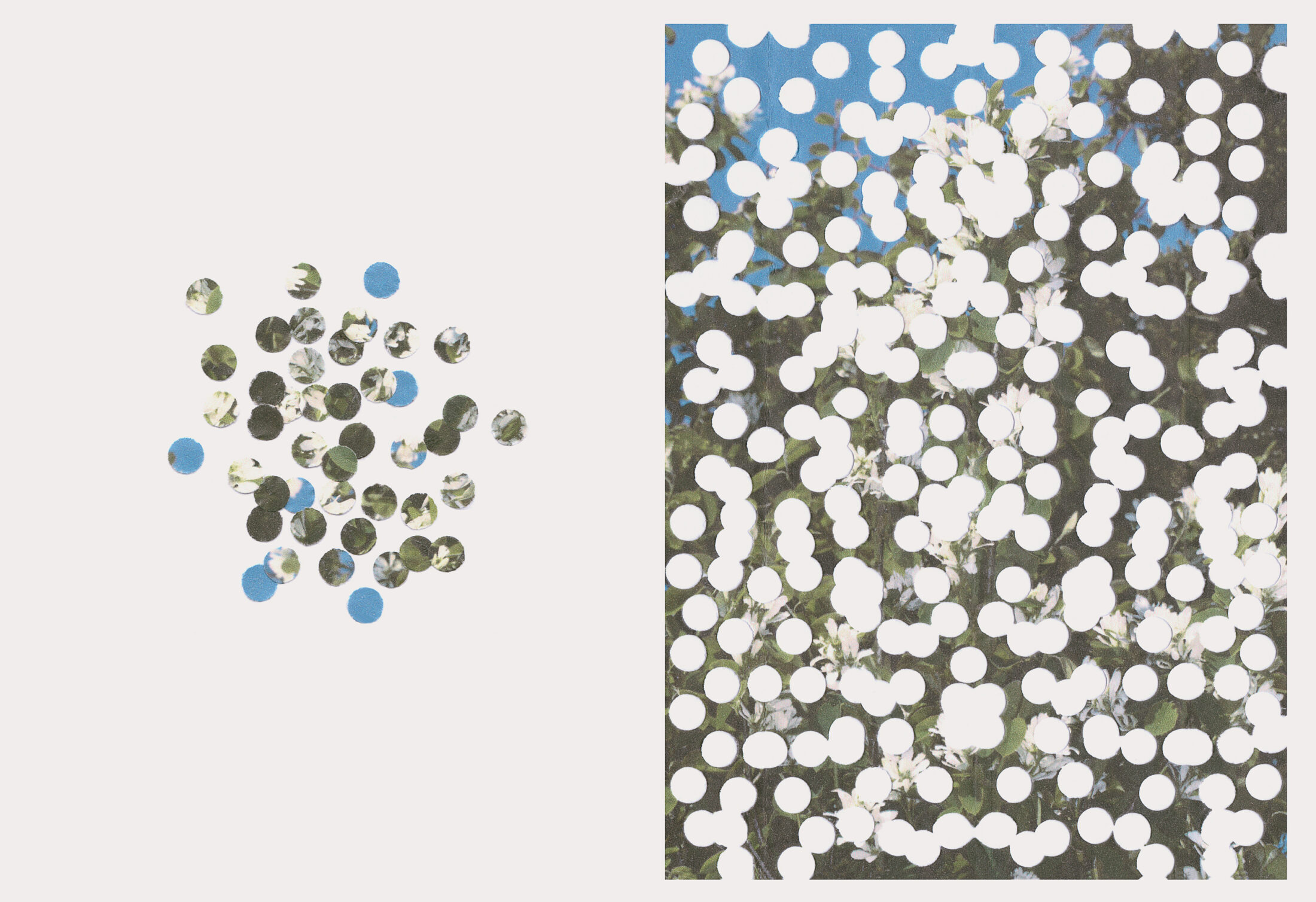
Valerie points out that even ecologists are reevaluating the assumption that intense competition is the primary force regulating evolutionary success. Evolutionary biologist David Sloan Wilson has found that competition makes sense only when we consider the unit of evolution to be the individual. When the focus shifts to the level of a group, cooperation is a better model, not only for surviving, but for thriving. In a recent interview, author Richard Powers comments, “There is symbiosis at every single level of living things, and you cannot compete in a zero-sum game with creatures upon whom your existence depends.” And yet, we continue to operate our economic systems from the foundation of competition. I think the Serviceberries discovered this long ago, and we humans need to catch up.
What if scarcity is just a cultural construct, a fiction that fences us off from gift economies? When I examine Serviceberry economics, I don’t see scarcity, I see abundance shared: photosynthate is usually not in short supply, since sun and air are perpetually renewable resources. Of course, sometimes there’s not enough rain, and then the scarcity ripples through the web of relationships, for sure. That is real scarcity: when the rains don’t come. A physical limitation with repercussions that are shared, just as abundance is shared. That kind of scarcity is not what troubles me.
It is manufactured scarcity that I cannot accept. In order for capitalist market economies to function, there must be scarcity, and the system is designed to create scarcity where it does not actually exist. Because I have not thought much about economics since my introduction to it in high school decades ago, I realize that I had just been accepting the principle of scarcity as if it were a natural fact, not an economic assumption.
I try and lay out the understanding for myself, to think like an economist, not an ecologist. In order for money to be made, there must be commodities to be bought and sold. The scarcer those commodities, the greater the revenue. So, I guess I do understand this: market economics demands that abundant, freely available, earthly gifts be converted to commodities and made scarce by privatization and a high price. This seems crazy, so let me test my understanding with the example of pure, beautiful water, a gift from the skies. It was previously unthinkable that one would pay for a drink of water; but as careless economic expansion pollutes fresh water, we now incentivize privatization of springs and aquifers. Sweet water, a free gift of the Earth, is pirated by faceless corporations who encase it in plastic shells to sell. And now many can’t afford what was previously free, and we incentivize wrecking public waters to create demand for the privatized.
In contrast, in Indigenous societies all over the world, where remnants of gift economies endure, water is sacred and people have a moral responsibility to care for it, to keep it flowing as the lifeblood of Mother Earth. It is a gift, to be shared by all, and the notion of owning water is an ecological and ethical travesty.
The Indigenous philosophy of the gift economy, based in our responsibility to pass on those gifts, has no tolerance for creating artificial scarcity through hoarding. In fact, the “monster” in Potawatomi culture is the Windigo, who suffers from the illness of taking too much and sharing too little.
At one point while writing this essay—as I was struggling to imagine how the ways of Serviceberries and ancient gift economies could help us imagine our way out of the mutually assured destruction of unbridled capitalism—I needed a break from the Windigo shadows that were creeping toward me. Thankfully, I was interrupted by a text from my neighbor, Paulie. As though she were reading my troubled mind from across the valley, Paulie invited me to come pick berries at her farm. Serviceberries. For free. The tingles of synchronicity propelled me from my desk to the orchard.
She planted this orchard with commodity in mind, part of her revenue stream as a small local farmer; an innovative crop destined for “pick your own” fees, which can be lucrative. But instead, she has invited her neighbors to come and pick for free. Her labor and expenses are not free: tilling, irrigation, and marketing cost real money. The trees cost money, as does the gas when Ed mows between rows—and the Serviceberries won’t be paying their own way.
She is losing the return on her investment by inviting us to come fill our buckets with this surfeit of sweetness. She is not obeying the rules of the capitalist market economy; she is not behaving in a way that will maximize her profit. How un-American.
In one fell swoop her berries rolled from the commodity column on a spreadsheet into the beribboned box called “gift.” The berries hadn’t changed a bit: they were still juicy and bursting with antioxidants. The farm hadn’t changed either. It’s a small, family operation, diversified with an array of crops that generate revenue all year—from early spring lambs to Christmas trees. The only thing that changed was whether the folks who came to pick berries were asked to put pieces of green paper into the coffee can inside the barn door.
I asked her why she did it, especially in these pandemic days, when every small business is struggling to make ends meet. “Well,” she said, “they’re so abundant. There’s more than enough to share, and people could use a little goodness in their lives right now.” People came to pick in the cool of the early evening, socially distanced at opposite ends of the rows, isolated yet somehow connected by the rhythm of fingers moving from bush to bucket—and mouth. “Everyone’s so sad now,” she said, “but in the berry patch all I hear are happy voices. It feels good to give that little bit of delight.”
But it’s also education, she says. Most people don’t know Juneberries yet, and giving them away is an invitation to try them. True, Juneberries have long been a staple food for traditional people who share habitat with Amelanchier alnifolia. Harvested in great quantities, they were used as the basis for pemmican, the original energy bar. Now used for making pies and jam and cramming your mouth full, they are celebrated as a gift from the land but are little known as a product in the market economy.
Paulie has a reputation to uphold for being no-nonsense in her approach to life, so she qualifies her explanation: “It’s not really altruism,” she insists. “An investment in community always comes back to you in some way. Maybe people who come for Serviceberries will come back for Sunflowers and then for the Blueberries. Sure, it’s a gift, but it’s also good marketing. The gift builds relationship, and that’s always a good thing. That’s what we really produce here—relationship, with each other and with the farm.” The currency of relationship can manifest itself as money down the road, because they do have to pay the bills. Free berries might translate to better pumpkin sales, because people will want to come back to a place they have a relationship with. “People feel like they got something more than they paid for,” she explained. “They learned about a new food, or watched the kids climb on hay bales.” Good feelings are the real value added. Even when it’s paid for as a commodity, the gift of relationship is still attached to it.
Hoarding won’t save us … All flourishing is mutual.
The ongoing reciprocity in gifting stretches beyond the next customer, though, into a whole web of relations that are not transactional. They are banking goodwill, so-called social capital. “Being known as a citizen is always of value,” she says. If someone leaves a gate open and her sheep end up in my garden, there’s a cushion of goodwill in place so that the munched dahlias may be forgiven. “The way I see it,” she says, “always value people over things. There’s that old line that farmers like to spout, ‘Without farmers, you’d be naked, hungry, and sober.’ But it goes both ways: without good neighbors, you’d also be alone, and that’s worse.”
And that customer who comes to value the smell of ripe berries and the view of lambs on pasture and the memory of their kids climbing on hay bales—they just might vote for the farmland preservation bond in the next election. That’s a fine return on investment from a free bucket of berries.
I cherish the notion of the gift economy, that we might back away from the grinding market economy that reduces everything to a commodity and leaves most of us bereft of what we really want: relationship and purpose and beauty and meaning, which can never be commoditized. I want to be part of a system in which wealth means having enough to share, and where the gratification of meeting your family needs is not poisoned by destroying that possibility for someone else. I want to live in a society where the currency of exchange is gratitude and the infinitely renewable resource of kindness, which multiplies every time it is shared rather than depreciating with use.
You might rightly observe that we no longer live in small, insular societies, where generosity and mutual esteem structure our relations. But we could. It is within our power to create such webs of interdependence, quite outside the market economy. Intentional communities of mutual self-reliance and reciprocity are the wave of the future, and their currency is sharing. The move toward a local food economy is not just about freshness and food miles and carbon footprints and soil organic matter. It is all of those things, but it’s also about the deeply human desire for connection, to be in reciprocity with the gifts that are given you.
The real human needs that such arrangements address are exactly what we long for yet cannot ever purchase: being valued for your own unique gifts, earning the regard of your neighbors for the quality of your character, not the quantity of your possessions; what you give, not what you have.
I don’t think market capitalism is going to disappear anytime soon; the faceless institutions that benefit from it are too entrenched. But I don’t think it’s pie-in-the-sky to imagine that we can create incentives to nurture a gift economy that runs right alongside the market economy, where the good that is served is community. After all, what we crave is not trickle-down, faceless profits, but reciprocal, face-to-face relationships, which are naturally abundant but made scarce by the anonymity of large-scale economics. We have the power to change that, to develop the local, reciprocal economies that serve community rather than undermine it.
In Sacred Economics, Eisenstein reflects on the economy of ecosystems: “In nature, headlong growth and all-out competition are features of immature ecosystems, followed by complex interdependency, symbiosis, cooperation, and the cycling of resources. The next stage of human economy will parallel what we are beginning to understand about nature. It will call forth the gifts of each of us; it will emphasize cooperation over competition; it will encourage circulation over hoarding; and it will be cyclical, not linear. Money may not disappear anytime soon, but it will serve a diminished role even as it takes on more of the properties of the gift. The economy will shrink, and our lives will grow.”
I see this in the example of my neighbors, both the farmers and the berries. Yes, they have to pay the bills and are part of the market economy, but with every commodity traded, they add something that cannot be commodified and which is therefore even more valuable. People come for a sense of connection to the land, a laugh with the farmer as a fellow human who cherishes the crisp fall air—not for the commodity of a pumpkin, which, after all, you could buy anywhere.
Continued fealty to economies based on competition for manufactured scarcity, rather than cooperation around natural abundance, is now causing us to face the danger of producing real scarcity, evident in growing shortages of food and clean water, breathable air, and fertile soil. Climate change is a product of this extractive economy and is forcing us to confront the inevitable outcome of our consumptive lifestyle: genuine scarcity for which the market has no remedy. Indigenous story traditions are full of these cautionary teachings. When the gift is dishonored, the outcome is always material as well as spiritual. Disrespect the water and the springs dry up. Waste the corn and the garden grows barren. Regenerative economies which cherish and reciprocate the gift are the only path forward. To replenish the possibility of mutual flourishing, for birds and berries and people, we need an economy that shares the gifts of the Earth, following the lead of our oldest teachers, the plants.




